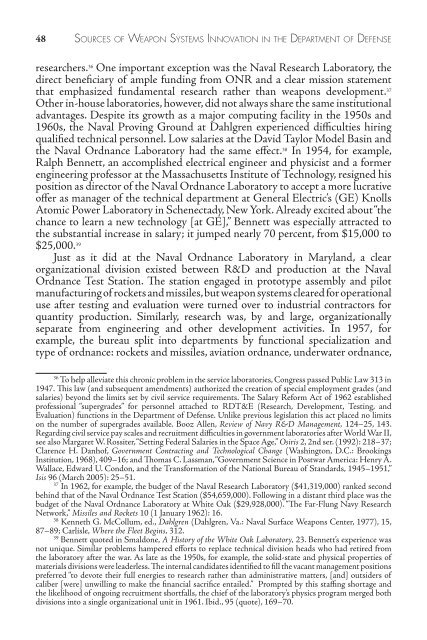To download as a PDF click here - US Army Center Of Military History
To download as a PDF click here - US Army Center Of Military History
To download as a PDF click here - US Army Center Of Military History
Create successful ePaper yourself
Turn your PDF publications into a flip-book with our unique Google optimized e-Paper software.
48 so u R c e s o f we a p o n sy s T e m s In n o v a T Io n In T h e depaR TmenT o f defense<br />
researchers. 36 One important exception w<strong>as</strong> the Naval Research Laboratory, the<br />
direct beneficiary of ample funding from ONR and a clear mission statement<br />
that emph<strong>as</strong>ized fundamental research rather than weapons development. 37<br />
Other in-house laboratories, however, did not always share the same institutional<br />
advantages. Despite its growth <strong>as</strong> a major computing facility in the 1950s and<br />
1960s, the Naval Proving Ground at Dahlgren experienced difficulties hiring<br />
qualified technical personnel. Low salaries at the David Taylor Model B<strong>as</strong>in and<br />
the Naval Ordnance Laboratory had the same effect. 38 In 1954, for example,<br />
Ralph Bennett, an accomplished electrical engineer and physicist and a former<br />
engineering professor at the M<strong>as</strong>sachusetts Institute of Technology, resigned his<br />
position <strong>as</strong> director of the Naval Ordnance Laboratory to accept a more lucrative<br />
offer <strong>as</strong> manager of the technical department at General Electric’s (GE) Knolls<br />
Atomic Power Laboratory in Schenectady, New York. Already excited about “the<br />
chance to learn a new technology [at GE],” Bennett w<strong>as</strong> especially attracted to<br />
the substantial incre<strong>as</strong>e in salary; it jumped nearly 70 percent, from $15,000 to<br />
$25,000. 39<br />
Just <strong>as</strong> it did at the Naval Ordnance Laboratory in Maryland, a clear<br />
organizational division existed between R&D and production at the Naval<br />
Ordnance Test Station. The station engaged in prototype <strong>as</strong>sembly and pilot<br />
manufacturing of rockets and missiles, but weapon systems cleared for operational<br />
use after testing and evaluation were turned over to industrial contractors for<br />
quantity production. Similarly, research w<strong>as</strong>, by and large, organizationally<br />
separate from engineering and other development activities. In 1957, for<br />
example, the bureau split into departments by functional specialization and<br />
type of ordnance: rockets and missiles, aviation ordnance, underwater ordnance,<br />
36 <strong>To</strong> help alleviate this chronic problem in the service laboratories, Congress p<strong>as</strong>sed Public Law 313 in<br />
1947. This law (and subsequent amendments) authorized the creation of special employment grades (and<br />
salaries) beyond the limits set by civil service requirements. The Salary Reform Act of 1962 established<br />
professional “supergrades” for personnel attached to RDT&E (Research, Development, Testing, and<br />
Evaluation) functions in the Department of Defense. Unlike previous legislation this act placed no limits<br />
on the number of supergrades available. Booz Allen, Review of Navy R&D Management, 124–25, 143.<br />
Regarding civil service pay scales and recruitment difficulties in government laboratories after World War II,<br />
see also Margaret W. Rossiter, “Setting Federal Salaries in the Space Age,” Osiris 2, 2nd ser. (1992): 218–37;<br />
Clarence H. Danhof, Government Contracting and Technological Change (W<strong>as</strong>hington, D.C.: Brookings<br />
Institution, 1968), 409–16; and Thom<strong>as</strong> C. L<strong>as</strong>sman, “Government Science in Postwar America: Henry A.<br />
Wallace, Edward U. Condon, and the Transformation of the National Bureau of Standards, 1945–1951,”<br />
Isis 96 (March 2005): 25–51.<br />
37 In 1962, for example, the budget of the Naval Research Laboratory ($41,319,000) ranked second<br />
behind that of the Naval Ordnance Test Station ($54,659,000). Following in a distant third place w<strong>as</strong> the<br />
budget of the Naval Ordnance Laboratory at White Oak ($29,928,000). “The Far-Flung Navy Research<br />
Network,” Missiles and Rockets 10 (1 January 1962): 16.<br />
38 Kenneth G. McCollum, ed., Dahlgren (Dahlgren, Va.: Naval Surface Weapons <strong>Center</strong>, 1977), 15,<br />
87–89; Carlisle, W<strong>here</strong> the Fleet Begins, 312.<br />
39 Bennett quoted in Smaldone, A <strong>History</strong> of the White Oak Laboratory, 23. Bennett’s experience w<strong>as</strong><br />
not unique. Similar problems hampered efforts to replace technical division heads who had retired from<br />
the laboratory after the war. As late <strong>as</strong> the 1950s, for example, the solid-state and physical properties of<br />
materials divisions were leaderless. The internal candidates identified to fill the vacant management positions<br />
preferred “to devote their full energies to research rather than administrative matters, [and] outsiders of<br />
caliber [were] unwilling to make the financial sacrifice entailed.” Prompted by this staffing shortage and<br />
the likelihood of ongoing recruitment shortfalls, the chief of the laboratory’s physics program merged both<br />
divisions into a single organizational unit in 1961. Ibid., 95 (quote), 169–70.

















